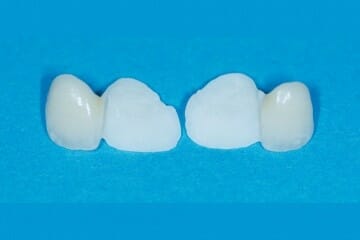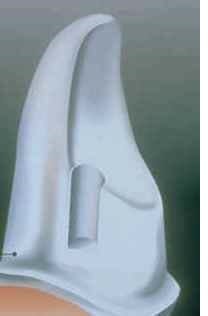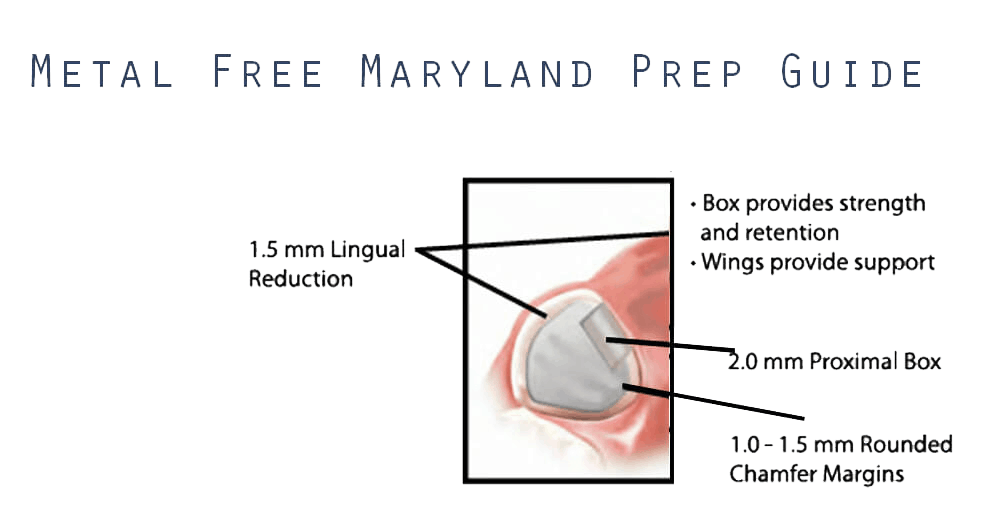Burbank Dental Lab has had a recent increase in prescriptions for Maryland bridges. The requests have been for a variety of styles, and a variety of treatment objectives, ranging from short-term provisionals to final restorations. There are few restoration categories that have resulted in as many questions, such as:
What is the right material?
What should the prep be, or lack thereof?
What are the cementation options?
I will not attempt to solve all controversies but will open a dialogue with a look at the different options.
Traditional Stand-By
The most common Maryland bridge for years have been the stand-by metal two-wing PFM (Fig. 1) However, over the last 20 years, a whole collection of metal-free options has been introduced. While these metal-free choices have been appealing from an aesthetic point of view, many of them require a rather aggressive prep, something that most clinicians are reluctant to do.
In this article, I will discuss a few of the options and where they may be most successfully used. While many configurations are used, one of the most common is replacing an anterior single pontic restoration. We will put our focus on that single pontic anterior bridge scenario.

Fig. 1
Single Wing vs. Two-Wing
The first point that I would like to put forward is to talk about the paradigm shift away from two wings to one wing. Much of the current thought and evidence coming out of institutes like Spear, Kois, Pankey, and universities like USC are pointing towards doing one-wing cantilever bridge for most treatment plan objectives, in preference to the traditional two-wing Maryland Bridge. (Fig. 2)
The prep of this method will depend on the original clearance and function, as well as the purpose of the restoration.

Fig. 2

Fig. 2b
Short-Term Provisional Cases (6 months & under)
If the case is a 6 month long-term temporary and the desire is for little to no prep for a restoration that is only being used while an implant integrates, a single metal wing is going to be the best solution.
- Very predictable bonding capacity, and minimal space requirement
- As little as .5 mm wing thickness
A single wing composite with fiber reinforcement can be done chairside or lab fabricated. It requires more occlusal clearance, about 1.5 mm and can be repaired easily chairside.
An e.max bridge with one wing restoration has very predictable bonding but needs more thickness, about 1.5mm, especially at the connector.
Short-Term Prep
- Metal wing - can be minimal, must have .5 mm clearance in MIP and lateral functioning.
- e.max wing - must have 1.5 mm clearance in MIP and lateral functioning.
- Composite - must have 1.5 mm clearance in MIP and lateral functioning.
It is important to note:
1. In all cases, the pontic restoration should be kept in minimal to zero occlusal forces, including any cross-over function.
2. Restoration should also be bonded to the interproximal of the abutment tooth.
Long-Term Provisional Cases (several years)
It is most predictable for long-term cases to make a single tooth abutment with cantilever. Prep requirements increase to allow the restoration and the adhesive to last for a longer period of time.
Material choices:
- Metal wing and substructure is the most predictable
- Composite with or without a ceramic veneer is the second most predictable
- e.max is the third most predictable.
- While zirconia is very strong, it has the lowest ability to bond so is less preferable due to possibilities that it may debond.
REQUEST YOUR FREE IMPLANT SUCCESS GUIDE BELOW
Success Guides
Long-Term Prep
Metal Wing
This should have at least 1 anti-rotation groove interproximal and a countersink on cingulum. The interproximal connection needs to be at least 2.5 m tall, and 2 mm thick. It may require an enameloplasty to create a broad contact area to which to bond, in addition to a 1 mm by 2 mm retentive groove. (Fig. 3)

Fig. 3
e.max or Composite Wing
This needs to have a 2 mm by 2 mm box interproximal and 1.5 mm thick wing. (Fig. 4)
Zirconia
This would require the same parameters as e.max. However, the bond strength is significantly lower and would be contraindicated by the manufacturer (and therefore not guaranteed by Burbank Dental Lab). If the choice is to use zirconia, use Kuraray Clearfil Ceramic Primer and Panavia SA+ or Panavia V5.

Fig. 4









